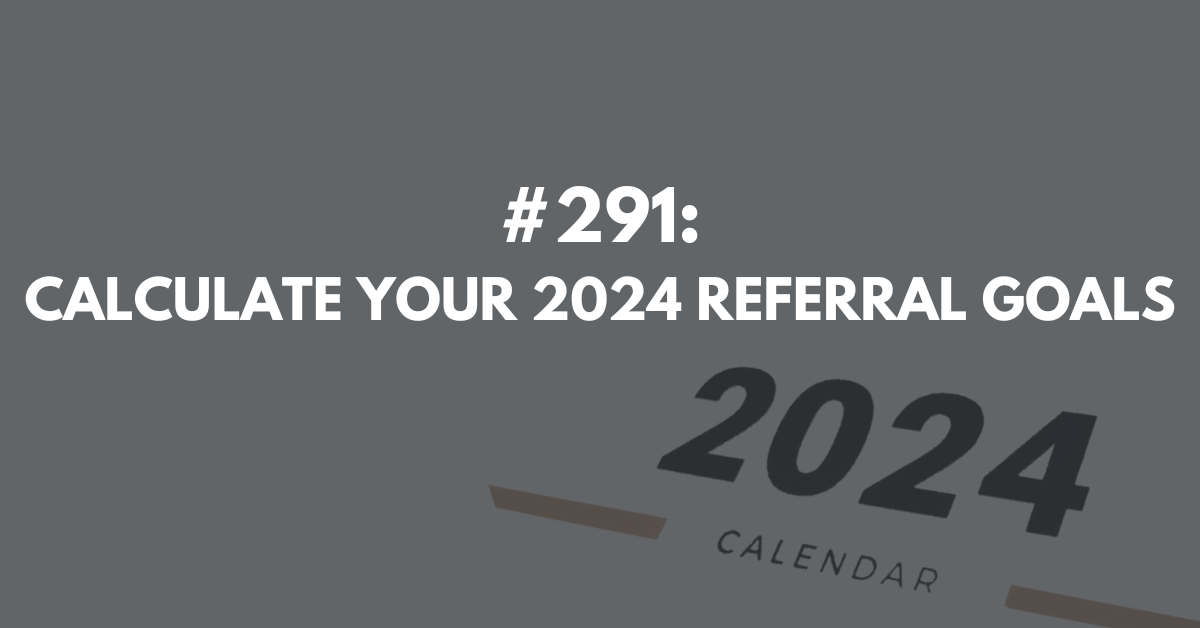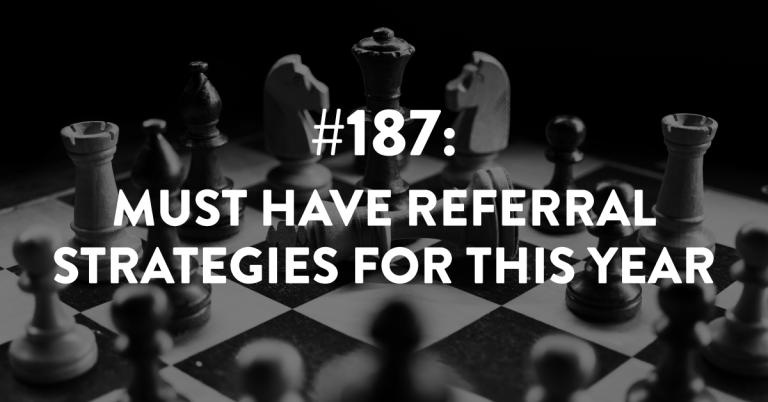Ep #291: Calculate Your 2024 Referral Goals (Part 1)
In our last episode, I shared the three key factors to consider when setting referral goals. This week, we go even deeper and focus on the second key factor – having the right data from your past referrals to inform your decisions for the future. Today, I take you through how to gather this data and provide you with a free worksheet to make the process easier.
By understanding your referral results from last year and analyzing your referral sources, you’ll gain valuable insights into your referral potential for 2024. Armed with this information, you can then set realistic and achievable referral goals for the year ahead.
I encourage you to take the time to listen to the episode and complete the worksheet. It may seem overwhelming at first, but trust me, it’s easier than it sounds when you have everything laid out on paper.
Be sure to tune in next week’s episode, where I’ll explain what to do with the data you pulled and how to calculate your numbers. If you have any questions or need further clarification, please reach out to me. I’m here to help you every step of the way.
Links Mentioned During the Episode:
Download the worksheet for data gathering so you can set your 2024 referral goals here.
Want to attend my free, live training on making your Referral Explosion Goals a reality this year? Then submit an application to join the Building a Referable Business™ coaching program. If approved, we’ll send you the training dates (two to choose from). There is no obligation to join BRB after applying or attending the training.
Listen to episode #290 to understand how this referral data fits into the bigger picture of your 2024 Referral Goals.
Next Episode:
Next episode is #292, which is another episode created with you and your needs in mind.
Download The Full Episode Transcript
Read the Transcript Below:
Stacey Brown Randall: More referrals this year starts with calculating your referral goal. So let’s do that together on this episode.
Hey there and welcome to episode 291 of the Roadmap to Referrals podcast, a show about helping you build a referable business. I’m your host, Stacey Brown Randall. My journey from a business failure to a successful business now 10 years in, I know generating referrals naturally and consistently has made all the difference. Working with clients around the world, we leverage the science of referrals, protect relationships above all else, and help you build a referral business.
In last week’s episode, that’s episode 290, I discussed the three keys that you have to be clear on if you’re going to set your referral goals.
And those three keys, although I think you should go back and listen to the episode if you haven’t listened to it yet, those three keys were understanding the capacity of the number of clients you could actually work within a year based on your life stage, and then taking in effect, or factoring in also understanding the data you had from your referrals last year, and maybe even years previous, and then of course understanding your growth expectations, which in some cases may be no growth, and that is an acceptable answer.
Okay, so for this episode I want to really go deeper and focus in on that second key piece and that’s having the right data from what has happened in the past with referrals as you make decisions on what you want your referrals to do for you this year.
Now this data is actually broken down into two sections. So how I’m going to lay out this episode is I’m going to break down these two sections for you. And that’s going to be the referral results from last year, and then the second section is actually your referral sources. So I’m going to walk you through both sections. And I’m going to be honest, it may feel like a lot.
If you’re listening to this episode right now as you’re driving to work or driving to the gym, or maybe you’re out blowing some leaves or something when you’re listening to this episode, it’s going to sound like a lot when you listen to it verbally. But when you see it written down on a piece of paper, you’re going to be like, oh, okay, that’s like one page, the front side of a piece of paper. So it’s not as much as it sounds when you actually look at it written down.
So because of that, I actually created a worksheet that you can go grab and you can get that from the show notes page. The show notes page for this worksheet is StaceyBrownRandall.com/291. That’s forward slash 291. And Stacey, of course, has an E.
So when you go to the show notes page, you can click on the link and you can just download this free worksheet that will, trust me, make this look way less scary. If you’ll just download the worksheet and then maybe go back and re-listen to this episode so you understand how to get to the individual points of the data that I want you to collect.
That’s what makes this sound overwhelming or makes this sound like a lot. It’s actually just the explanation that I’m giving you of like where to find that information or where that information comes from for these data points. But overall, these data points, they’re not complicated to pull. They’re not actually a lot to pull, but it may sound like it. Trust me, go get the worksheet, StaceyBrownRandall.com/291. Go get the worksheet, and trust me, it’ll make this so much easier, okay?
So here’s the thing. First, we’re gonna talk about that first section I said, which is the referral results. And I’m gonna walk you through pulling that data so you can pull it all together. So first thing is the number of referrals that you received in 2023. That is always a good starting point of what happened last year.
Now, clarification for those of you who may be new around here, or maybe you’re a first-time listener, or maybe I need to repeat this for the people in the back who don’t ever seem to get it. It’s for either group, I guess.
A referral comes from another human. A new client does, or excuse me, a client who comes back to work with you again does not refer themselves. Their source is actually a repeat client. It’s not a referral source with their name as the referral source and the client, okay?
So if a client comes back to work with you, that source is a repeat client, not a referral. You do not get referred from an organization like a networking group or an organization or association that you’re a member of.
You are referred by somebody in that group, unless you met the person at an event. And then the source is not the group where you met them, it’s the fact that you went to that event and that’s where you met them. So we have to be clear on this.
And I know people are like, okay, Stacey, you are getting nuanced. Yes. Yes. Yes, I am. Because when we are going to build a strategy, to how to get more referrals from where our referrals came from in the past, we gotta need to have the right information, okay?
So, when you’re looking at the number of referrals you received last year, that is a human referred to another human. Now, there are obviously some one-offs in this, right? And that could be, well, this person actually came through word-of-mouth buzz, but they reached out to me and told me that Andrew told them they should talk to me. Well, then we’re still going to give Andrew the credit.
So if somebody comes to you and they’re like, hey, you were recommended to me, you were referred to me, I want you to get that information from them. I want you to know, well, who recommended you? Who referred you?
And so it may not be it came the traditional way that I wanted to come for you, which is like in an email and the referral source copies the prospect on it and copies you and connects you two together. That’s perfect world. That’s how we want it.
But it also could mean that they did talk to you, like a referral source was out there talking about you. That person was like, okay, great. I’m going to go have a conversation with Alex and just tell Alex, by the way, Stacey told me to talk to you. I still want you to count that as a referral for Stacey in the use of this example, right?
Because trust me, if we want Stacey, this is weird talking about myself like this in third person. If you want Stacey to give you more referrals, you’re going to need to acknowledge that they kind of almost gave you a referral in the past. So there are some one-offs on this.
I’m not looking for perfection, guys, here with your data. I’m looking for as close to complete as you can get it. It is really important for you to understand and for you to recognize that with these referrals, when you’re pulling this information, it should be, here are all my clients from 2023. And here’s where they came from. And now I’m looking for the ones that came from another person.
You’re also going to do that with your prospects. Here are all my prospects that came in 2023, the ones that did not become a client, or said not yet, or are still in process. And here’s where they came from.
How many? I need a number. It’s one number. It’s not a range. It’s not, oh, it’s 10 to 15, or it’s 27 to 32. Is it 27? Or is it 32? Or is it 30? Or is it 12? Like, it’s a number. This is how many referrals that I received last year.
You may have some holes in your data. You may be off by a few. That’s OK. Get it as close to around, not around, as close to a number, not a range. That’s what I meant to say. I meant to say range, not around. I don’t care if it’s, like, it doesn’t need to be 30 if it’s 32. It’s 32, right? But I don’t want a range. I need you to pull this information.
The next thing is that’s the number of referrals you received in 2023. The next thing I need you to understand is how many of those actually became clients. How many of those referred folks actually turned around and then paid you money and became a client? This is important because it helps us determine the third metric, which is your closing ratio.
Now, here’s the thing. When you’re setting goals for 2024, and we’re going to talk about this as we move along, when you’re setting referral goals for 2024, we don’t just set a goal for the number of referrals we want. We also talk about, well, how many of those do we want to convert into paying clients?
We do data here, my friends, and we get into the metrics. So not only do I want you to know, here’s how many referrals I received in 2023, I also want you to know, okay, of the 50 referrals I received in 2023, 25 of them became clients, which then tells me the third metric, which is your closing ratio. Which is I have a closing ratio of 50%. I typically close 50% of my referred prospects into paying clients. So those are three points of data.
The next thing I want you to know is when you close those 25 of your 50 referred prospects, you close 25 into paying clients, how much money was that? How much money was that? So what’s the amount of revenue that came from those closed clients that were referred to you?
So this is a two part one. So first, it’s how much revenue or if you’re like a real estate agent, you work off commission or you’re in sales and you work off commission, maybe the number for you is commission. It’s not revenue. But if you’re a business owner, it is revenue.
So the amount of revenue or commission that you actually closed from those referrals, and then a little sub number is also the amount of revenue or commission that is actually still in play or in process because those referrals haven’t closed yet. But it means you have a good feeling about some referrals closing.
So let me give you this as an example. I have some folks that were referred to me in 2023. 2023 wasn’t the year for them to join my coaching program or work with me at the VIP level, Referrals in a Day, but that’s what they want to do. But it wasn’t the right time for them to make that decision in 2023. They are planning to make that decision in 2024.
Now, of course, anything could change as 2024 unfolds. But what I’m paying attention to is people who are showing a very strong interest, and then have said, this is something I need to do first quarter or second quarter of 2024.
Now, it’s up to me to stay in touch with them, right, and to make sure I don’t let them forget that’s what they said. But the truth is, there are some people referred to me last year that I believe have strong potential to close this year and to become a client of mine.
And so in that case, what I would make, the revenue that I would make from that client, that’s what goes in this line. I don’t know 100% if it’s actually going to close, but I have a good feeling about it. So it could still close. It’s in play. It’s in process, or it’s as close to being in process as possible. What’s the revenue that’s going to come out of those folks as well?
And then you should also always know the number of referrals that you received who really were not a fit, because this helps us identify patterns, which we’ll talk about later. So this is our basic of our referral results. And I went through each of these as how to pull that data.
It all starts with that very first number you have to pull is how many or the number of referrals did you receive in 2023. OK? The number of referrals that you received in 2023 then tells you everything you need to know.
How many of those became paying clients? Then what is your overall closing ratio of referred prospects to paying clients? How much revenue did you make off of those closed referrals? How much more revenue may you possibly make because that’s still in play or in process?
And of course, of those referrals you received, how many were not a fit? You would never be able to work with them or make money, right? And so maybe you had to tell them no, or you had to refer them to someone else.
Those are the six pieces of data I want you to gather in this first section for referral results. And I just kind of gave you an overview of how to pull it.
Now, if you’re trying to pull this information and you’re like, wait, I’ve got a question, guess what? I’m a human. You listen to me all the time. I’m in your earbuds probably right now as you’re like walking on that treadmill.
Email me. I welcome your emails or send me a direct message. I prefer you direct message me on LinkedIn or Instagram. Those are the two that I’m more likely to check. And so if you have questions going through this, then I want you to ask me your questions and let me solve your problems for you. Because guess what? I do it all day long for my clients. I certainly can do it for you as well.
Okay, next up is the second section and the second section to this is your referral sources, but it’s important that we look at our referral sources and two specific ways.
Hey there, pardon the interruption. If you haven’t caught on, the theme of this month on the podcast is helping you set referral goals. Yes, goals with an S. Because we set more than just one, we measure multiple factors. If you want to do this with me live, which is kind of like listening to the podcast, but actually looking at me in the face and getting feedback right away. If you want to do this with me live, you have two spots to choose from for live training I’m doing this month.
It’s time you finally realize the referrals you deserved. In this training that I’m doing, offering it two different times in January, I will walk you through how to calculate your referral goals. That’s your potential, my friend, for this year. And how to hit that goal. We call it strategy stacking.
Guess what, though? There is a catch. To attend this training, you first have to apply for my coaching program, Building a Referable Business, or BRB for short. Now, of course, there is no obligation to join BRB after attending the training or submitting an application. But this training is only for those who fit our criteria. And for me to know if you fit the criteria, you have to complete an application.
So I want you to go to StaceyBrownRandall.com/referable. to learn about the BRB coaching program, get the training dates, and of course, click on the link to submit your application. That’s when we’ll get all that information to you about the training once you submit your application. Okay, now let’s get back to the episode.
All right, so right now we are paying attention to your referral sources. We talked about referral data from 2023 and what that kind of looked like, and now we’re paying attention to our referral sources.
If you want more referrals, you need to start with the one group of people who have the best chance of giving you referrals, which are those who’ve already referred you before. And there are two metrics you need to know when it comes to your referral sources.
So let me walk you through what these two metrics are, and then I’m gonna walk you through how to compile your list of referral sources, and then I’ve got a couple of considerations I want you to note before you make any decisions.
Okay, so first, the number of referral sources you had January 1st of 2023. I did not misstate that. How many referral sources did you start the year with at the beginning of last year? Which means how many referral sources did you have at the end of 2022? Which means that’s who you started the year with at January 1st of 2023.
Now, if you’re sitting there thinking, well, I have no idea. All right, remember, there is a worksheet that you can download that’ll help you compile this information. It’s got some good tips in there for you. Go to staceybrownrandall.com/291. That’s for episode 291, and Stacey has an E. Download this worksheet. It’s free.
Okay, so you’ve got to figure out, though, how many referral sources did I have January 1st of 2023? And then this feeds into the second number, which is how many new people did you add as referral sources, meaning they referred you for the very first time in 2023? So there’s two numbers there.
So I’m going to use some round numbers to make math easy on me, right? Let’s say January 1st of 2023, I started the year with 10 referral sources. And throughout the year, by really doing nothing, you did do something, you just don’t know what you did, but let’s just pretend, right? You know, you probably think, oh, I don’t know what I did, but I don’t think I did anything, but maybe I did something. I had five new people refer me for the first time ever. So I ended the year with 15.
So your numbers are, I had 10 referral sources at the start of 2023, and I added five new people. So now I have 15 referral sources. Okay, let me break this down for you. If you’ve never compiled your list of referral sources, you can’t come to these numbers. So let me walk you through how to compile the list of your referral sources so that you can then get to this number.
Okay, here’s what this is going to look like. Here’s how you do it. The first thing you’re going to do is do a client look back. This is actually, these two things I’m about to tell you, is actually what every single person does when they join BRB, my coaching program, is this is their pre-work.
They actually have to complete their pre-work before they have their onboarding call with me scheduled. So it helps me know everything I need to know about how we’re going to get you results this year, once I see your pre-work.
I know people are like, what do you mean? I just do a couple of tabs on a spreadsheet, and you can know everything you need to know. I’m like, because I’ve been doing this for 10 years, my friend, that is how. So this is basically what I would have you do. This would be the pre-work. So I want you to do it now because you’re going to need it to do some calculations for your goals for 2024.
So client look back. I want you to look back over the last three years. And I want you to write out all of your clients’ names and then, of course, I want you to write out how they learned about you, the source.
So this looks like three columns in a spreadsheet. The year is the first column. The client’s name is the second column. And the third column is source. So this would be all of your clients from 2021, 2022, and 2023. You’re gonna list out all your clients.
If you have 12 clients a year, right? You’re gonna list out 12 from last year, 12 from the year before, 12 from the year before that, right? If you have 50 something, great. You’re gonna do that, however many new clients you brought on board in 2023, 2022, and 2021.
You’re also going to list out the source. Not every single person who comes to you is probably coming by referral. Maybe someone’s coming through a networking group. Maybe someone is a repeat client. Maybe someone you actually sent out a LinkedIn message to, and they responded, and that started a dialogue, and then they became a client.
Maybe they answered an ad that you had placed in a publication. Maybe they saw some PR that you earned. Maybe they’ve just known you forever and ever and ever, and they’ve just been in your network, and they finally decided to pull the trigger and work with you.
There’s lots of different sources. But you’re going to pull a list of your clients, and then as best you can, you’re going to say how they learned about you. And you’re going to do that for your clients in 2023, 2022, and 2021.
Then you’re going to do what’s called a prospect look back. Now, if you can go back three years, amazing. Most people can give me a year, and that’s fine. That means you’re going to list out all the people who didn’t become a client, the people who stayed a prospect in 2023. They stayed a prospect, never became a client from 2022, and the same thing with 2021.
So once you have this client data of your clients, the year they became a client, and where they came from, and then you have as much data as you can pull for your prospects, the year they became a prospect, the prospect’s name, and how they heard about you, where they came from, you’re going to merge that together. And then you’re just going to look for the names of people that were your referral sources.
And that is what you’re counting. And you’re counting it by year. So actually, you’ll be able to know how many referral sources that you had at the start of 2023 by looking at your 2022 data. And then anybody new that’s on that list from 2023 and they haven’t been on the 2022 list or the 2021 list, look at how that works. They become a new referral source because they’ve referred you for the very first time last year.
Now again, if you have questions while you’re doing this, I get it. Just ask, please. Do not sit in confusion. I can solve this probably by answering an email or a direct message in probably like 30-something seconds. So just ask your questions. Sometimes you just get all up in your head and you overthink it, and I can help you underthink it so you can get it done.
So when you think about pulling your client and your prospect look back, it’s giving you everything you need. You’re just going to have to sort it correctly. So you’re going to have to pull out the clients and the prospects that were referred to you with the referral source’s names and then just look.
Hey, how many referrals did I get in 2023? How many referrals did I get in 2022? How many referrals did I get in 2021? Pull all of that. That’s all good data.
Now, I asked you specifically in the first section to know how many referrals you got last year in 2023. But if you can also pull 2022 and 2021, awesome. The worksheet will guide you through that too. It’s like extra bonus goodness for me to work with when we start talking calculations.
That data that you’re going to pull with your client and prospect look back is going to help you answer the first section under referral results, and then what you need to know about your referral sources.
And remember, what we’re looking for referral sources is the number of referral sources at the start of 2023. So January 1st of 2023, how many people had referred you in the last year or two that had potential to refer you in 2023? Was that five people? Was it 25 people? Was it 33 people? And then how many people referred you for the very first time they became a new referral source last year?
Okay. Here are some considerations that I just want you to keep in mind, right? If somebody referred you for the very first time in 2023, they are special. So even if who they referred to you wasn’t a fit, and you couldn’t work with them, or they said no, that doesn’t mean anything, they stay on the list.
Sometimes people look at the list of their referral sources, and they look at the list from the 2023 people who referred them for the very first time, and they’re like, yeah, but it didn’t become a client. Or yeah, but it wasn’t the right fit. That’s OK.
Until someone shows you a pattern of referring you people you cannot help, we keep them. Because when we start talking about, hey, we may need to make some decisions on who stays and who goes, if they referred you for the first time last year, keep them on your list.
The other thing here is now you know who referred you in 2021, who referred you in 2022, and then you can decide, did they refer you in 2023? If they didn’t, maybe they’re not gonna be on your master list of referral sources moving forward.
Because where you’re ultimately headed is what’s the number, right? What’s the number of people that you believe will refer you again in 2024? That number is really, really important. So once you have made that decision and you know, okay, these are the people that I think have potential to refer me in 2024, we’re gonna use that as part of our calculations.
But to get to who’s on my master list of referral sources starting on January 1st of 2024, is determined by who referred you in 2023, also in 2022, also in 2021. Who on those lists are you keeping and moving with you into the next year?
Again, if I’m going through this and you’re like, I get it, I hear her, I’m looking at the worksheet, I think I’ve got it, but I’ve got a question, what are you going to do? You’re going to email me or direct message me and let me answer that question.
Or better yet, why don’t you sign up for that training I talked about in the part in the interruption section. Complete your BRB application. Come to the training. I’m doing two options to choose from in January. They’re not for another week or so.
Come to that training, and then you can talk to me about it live, which is sometimes even more fun. But we’re going to do that calculation part during that training as well, because I think it’s fun to do it live. So we’re doing it live in that training.
Okay, so here’s the thing. When you know who is on what we call your master list of existing referral sources, that’s based on the number of referral sources you had at the end of last year. So, when you look at how many referral sources that I have at the start of January 1st of 2023, plus who referred me for the very first time and became a new referral source, that number gives me the number of referral sources I have for 2024.
But on that list, there may be people who consistently refer you. They referred you in 2022 and 2021 and 2023, right? So that’s why we just want to look back and we want to make sure we’re not forgetting anybody.
And there could be people in 2022 that referred you that just didn’t in 2023, but you feel like they will still refer you. Maybe even from 2021. That’s why you pull that data. So you can grab those folks and put them on your list and make them a part of your master list of existing referral sources for 2024.
Because as I said, the easiest group to start with if you want to get more referrals in 2024 are the people who have already referred you. That’s where we want to start, all right?
So the question is, is how many referral sources are we cultivating to give you more referrals in 2024? That’s the ultimate answer you’re going to have with this section.
So once you have all this data from the first part, which is referral results, and the second part, which is referral sources, we’re going to use it to calculate your referral goals. Trust me. Stick with me. It’s all going to make sense. But I am giving you exactly one week to pull this data together.
So I’m not going to go over the calculations right now. You and I are going to meet back here next week, same time, same place, this episode, but next week’s episode, episode 292. And I’m going to walk you through what to do with this data you pulled and how to calculate your numbers.
So remember, the worksheet that I mentioned that you can download to make this data gathering easier. Right? And of course, if you want to also go back and reference the other episode I mentioned, 290, you can do it on the show notes page for this episode. You can download that worksheet at StaceyBrownRandall.com/291.
Trust me, when you see this in writing, you’re going to be like everything Stacey just said on this episode made sense. So go do that. Okay, go do that, pull out this information, pull this data together, and then join me next week on next week’s episode 290, and we’re going to crunch some numbers. I’m going to give you a simple formula to follow, and we’re going to set some referral goals for 2024.
Okay, which means you know what time it is of this episode. It’s time for me to say goodbye. We are going to be back next week with another great episode. I just told you all about it. So until then, you know what to do, my friend. One, download your worksheet. Two, pull your data. And three, take control of your referrals and build a referable business. Bye for now.







